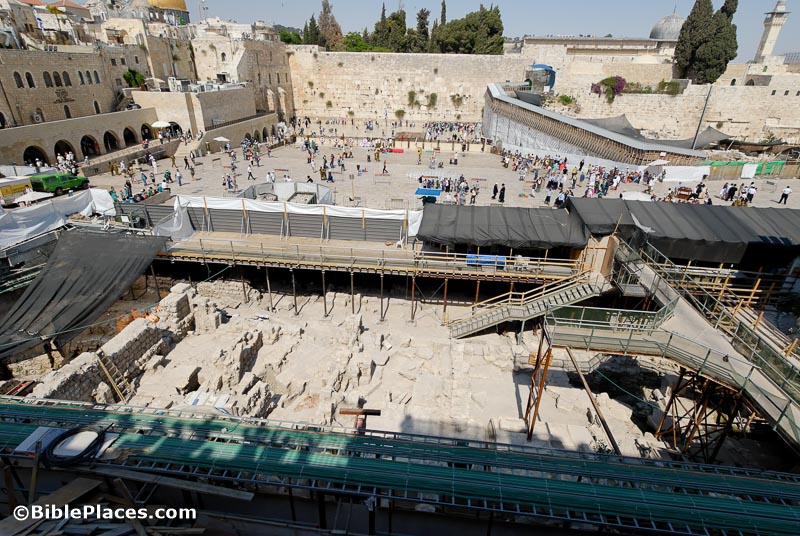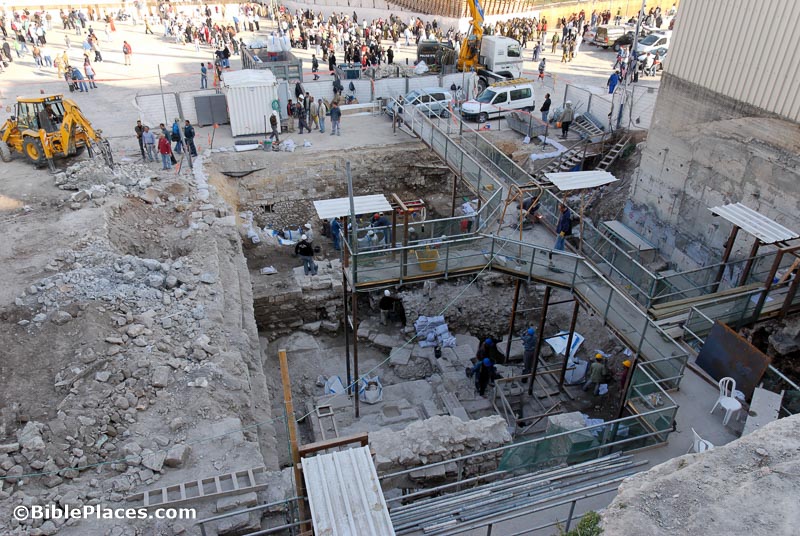For many years there was a big pit at the back of the Western Wall prayer plaza. If you climbed up the hill, you could see over the barrier walls and watch the hole get deeper. But it was difficult to know what they were finding. One natural guess, given the position of the pit, was that they would find the eastern branch of the Cardo. And they did. They continued digging and discovered a house from the Old Testament period. Their findings are given in a chapter of Ancient Jerusalem Revealed entitled “A First Temple Period Building and the Roman Eastern Cardo in the Western Wall Plaza.” The authors are the archaeologists Shlomit Weksler-Bdolah and Alexander Onn.
 |
| Western Wall plaza excavations, 2008 |
Below all of the human remains, the archaeologists found bedrock that had been quarried in the 7th century BC. On top of that, they found a portion of a “four-room house,” also dating to the 7th century. In the Bible, the two most significant kings ruling over Jerusalem in the 7th century were Manasseh and Josiah. So this house was likely built during the reign of one of them.
They uncovered a portion of the house that measures 27 x 27 feet (8.5 x 8.5m). The walls were preserved to a height of—get this—16 feet (5 m)! That is very unusual for something this old, with all of the later bulldozers to come through (I’m thinking here of Nebuchadnezzar, the Romans, the Persians, even Herod). The structure was well-built, with “uniform, homogeneous courses of slightly trimmed stones.” The layout of the house had three parallel rooms, characteristic of the “four-room house.” The fourth room, running along the back, was beyond the area of the excavation.
The destruction of the building is interesting. The archaeologists determined that the building was destroyed quickly, either by an earthquake or more likely by the Babylonians. Yet the building lacked complete vessels, indicating that the house was abandoned before the destruction. One theory the excavators suggest is that the inhabitants may have been deported to Babylon in the days of King Jehoiachin (2 Kgs 24:12-16).
 |
| Western Wall excavations, 2006 |
What do you think they found in the house? If you’re an archaeology fan, you might just pause here and think about what you would expect to find in a 7th-century house in Jerusalem. You should get some of your guesses right, because the findings are not surprising.
1) Pottery characteristic of the 7th and early 6th centuries.
2) Lots of figurines. About 450 fragments of females, male riders, and animals. This almost sounds like a toy store. A particularly interesting one is of a lion with a small animal in its mouth. This may be a lion having lunch or a lioness carrying its cub.
3) Personal seals with Hebrew names. One of these seals has a cool depiction of an archer. (I’d like a seal like that, please.) Inscribed names include: Hagav, Netanyahu, Yadayahu, and Nawa or Nera.
The archaeologists consider the seals of most value in determining who lived in this house. They believe that these seals “suggest that its inhabitants belonged to the upper class and perhaps served as part of the administrative apparatus in Jerusalem.”
I suppose that we can imagine that the people who lived here were well-connected in Jerusalem, and it’s quite reasonable to think that they may well have been acquainted with Jerusalem inhabitants we know from the Bible, such as Jeremiah, Ezekiel, Zephaniah, and Josiah.
The article continues with what they found from later periods—primarily the Eastern Cardo. I hope to to read and summarize that here next week.